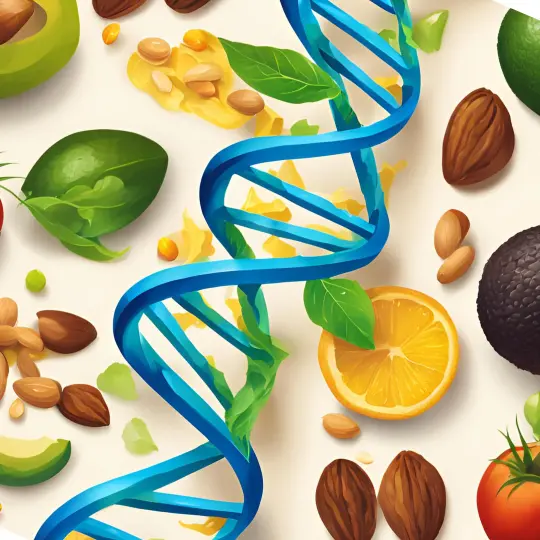Scylex Lab
09-Dec-2024
How Do Your Genes Respond to Dietary Fat?
Fats are essential in the diet, supporting inflammation regulation, brain health, and energy storage, but finding the right balance is key. Excessive intake can contribute to weight gain due to higher calorie consumption, while insufficient fat intake can disrupt hormone balance and hinder the absorption of fat-soluble vitamins.
Understanding genetic predispositions related to fat metabolism helps to better grasp how the body processes and utilizes different types of fats.
Types of Dietary Fats
Unsaturated Fats
Unsaturated fats are often referred to as “good fats” and include monounsaturated fatty acids (MUFA) and polyunsaturated fatty acids (PUFA). These unsaturated fats can help reduce LDL “bad” cholesterol levels in the blood to lower the risk of heart disease.
Omega-3s are a type of polyunsaturated fat well known for their benefits in improving heart health, reducing inflammation, and supporting brain function. Salmon, sardines, mackerel, chia, and flax seeds are good food sources of omega-3s.
Omega-6s are another polyunsaturated fat associated with a lower risk of cardiovascular disease. Since Omega-6s are very prevalent in a typical Western diet, their intake tends to greatly exceed that of omega-3s, leading to a more pro-inflammatory state.
The current average American intake is at a ratio of about 20:1 (omega-6/3). Reducing this ratio of omega-6 to omega-3 intake in the diet is important for reducing inflammation, allergies, and autoimmune reactions.
Saturated Fats
Saturated fats are often called “bad fats” because they can increase LDL levels and the risk of heart disease. Saturated fats are found in meat and dairy products like beef, poultry, pork, butter, and cheese.
The American Heart Association recommends limiting saturated fat intake to about 6% of total calorie intake. Less than 30% of Americans meet this guideline.
How Fats Function in the Body
The Dietary Guidelines for Americans recommends getting 20-35% of calories from fat. While too much dietary fat can lead to excess calorie intake and weight gain, taking in too little can also have negative health implications. Fats are necessary in the diet as they provide many functions in the body:
-
Insulate the body to stay warm
-
Provide cushion around organs
-
Help with the absorption of vitamins A, D, E, and K
-
Integral to cell structure
-
Help with hormone production
-
Source of stored energy
-
Reduce inflammation
-
Support brain development
Fat Metabolism
Fat metabolism varies from person to person and is influenced by genetic differences that impact how fats are processed, stored, and used for energy. Important genes such as PPARα, LPL (lipoprotein lipase), and the APO family play critical roles in managing how your body handles various dietary fats.
Genetic Variability
APO Genes: Variations in apolipoprotein genes, such as APOE, significantly influence lipid metabolism. For example, individuals with certain APOE polymorphisms may be more susceptible to increased LDL cholesterol levels when consuming saturated fats. These individuals may want to consider a diet higher in unsaturated fats.
LPL Genes: Genetic differences in the lipoprotein lipase (LPL) gene can affect the body’s ability to break down triglycerides, which is key for efficient fat utilization. These variations can influence one’s body fat and susceptibility to metabolic disorders.
PCSK9 Gene: Variations in the platelet activation and proprotein convertase subtilisin kexin 9 (PCSK9) gene play a role in regulating LDL cholesterol levels. The variants in this gene tend to increase the risk for hypercholesterolemia, indicating a need for strategies to manage cholesterol levels, including dietary changes.
FADS1 and FADS2 Genes: These genes code for desaturase enzymes that regulate the conversion of dietary PUFAs into longer chain fatty acids, including omega-3s. Therefore, variations in these genes can influence the availability of omega-3 and omega-6 PUFAs. Some of these FADS variants are associated with being overweight, a higher risk for cardiovascular disease, and declining cognitive function.
PPARα Gene: The peroxisome proliferator-activated receptor α (PPARα) gene plays a key role in fatty acid breakdown, particularly during fasting or exercise. It turns on certain genes that make the liver break down fats, which then provide energy for other parts of the body. Genetic variants in the PPARα gene can increase the risk of dyslipidemia, cardiovascular disease, and type 2 diabetes.
Summary
Genetics significantly influence how the body metabolizes various types of fats, making personalized nutrition crucial for achieving optimal health. Knowing one’s genetic profile can help tailor dietary recommendations—like reducing saturated fats for heart health or increasing PUFAs for their anti-inflammatory benefits.
A better understanding of these genetic predispositions can guide more suitable diet plans, ensuring balanced fat intake for inflammation regulation, brain function, and energy storage.
Curious about how genes impact the body’s response to dietary fats? Consider genetic testing to uncover insights into the body’s unique fat metabolism.


